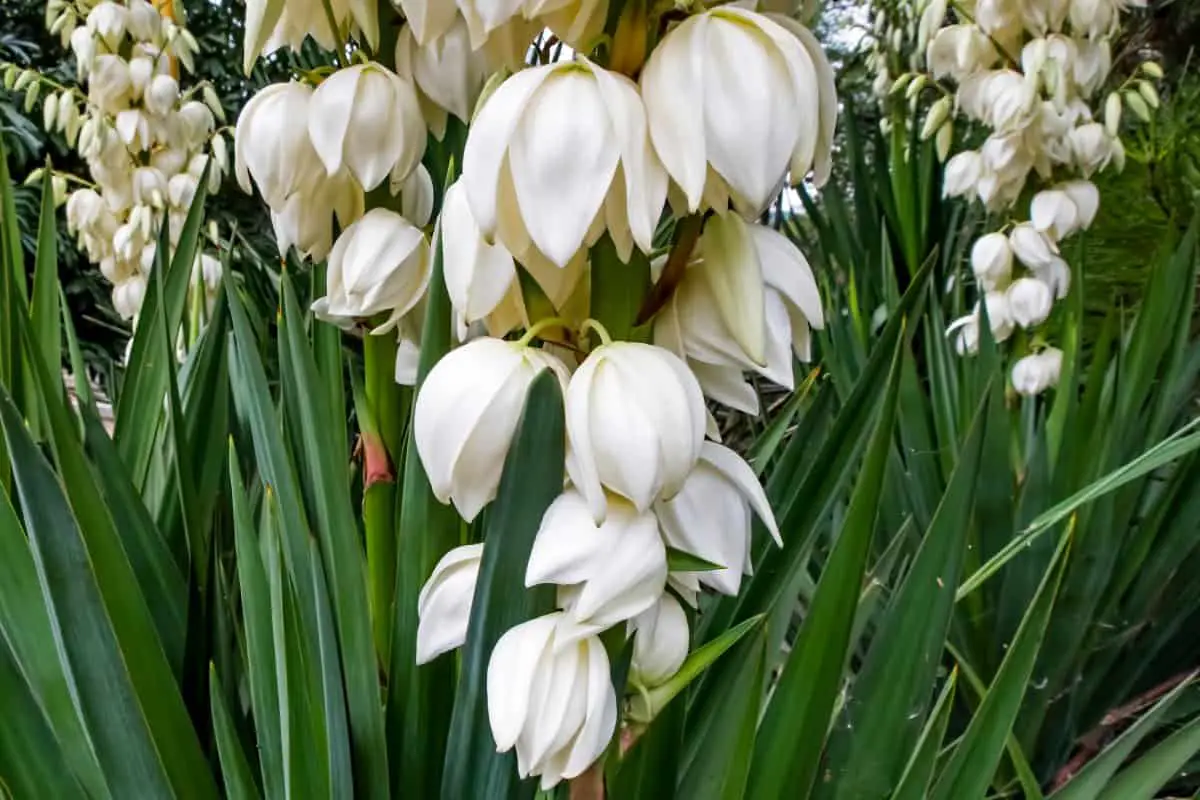Yucca plants are tall and spiky plants often used in landscaping and decorating. They have a beauty about them with long-lasting flowers of different colors.
All mature yucca plants can produce a flower. Yuccas produce a white or red bell-like flower that blooms annually. Most yucca plants have a solitary flower spike, but some varieties grow in clusters.
All yucca plants produce flowers, but not all varieties bloom every year. Some varieties only flower after several years, while others may never flower at all (and this is perfectly normal). We’ll look at what conditions these plants need to bloom, and which produce flowers annually.
How Often Do Yucca Plants Bloom?
Yucca plants are hardy plants that are easy to grow. They can be used as a hedge, accent plant, or in groupings for dramatic effect. Their stiff leaves and sharp tips make them an attractive addition to the landscape design of any yard.
Yuccas bloom once a year. Depending on the variety, they generally bloom from the middle of summer to early fall. If a yucca blooms in the early spring, it might bloom again in the fall.
Some variations bloom more often than once per year, so understand what type of plant you are growing to determine the blooming schedule. Some Yucca plants won’t have their first flowering for at least three years.
For example, Y. Elephantipes, also called the Spineless Yucca, is a large-leaved variety that forms clumps up to six feet wide and seven feet tall. This variety produces flowers only every two or three years.
The Conditions Needed for Yuccas to Flower
There are multiple conditions that your yucca plants need to regularly flower. These conditions are necessary to prevent diseases like root rot and allow the plant to bloom regularly.
Proper Lighting Conditions
Yucca plants prefer six hours or more of direct sunlight per day but can grow in lower light conditions.
A good rule of thumb when placing them outdoors with less-than-ideal lighting conditions is to place them where they will receive at least one hour of morning sunshine and another in afternoon or evening sunshine.
Nutrients Through Fertilizers
Yuccas need proper nutrition to grow and bloom. A good fertilizer specifically for cactus is required. To properly fertilize your yucca plant, you can use either liquid or granular fertilizers on the plant and apply according to label instructions.
Be sure to look for a fertilizer specifically for cacti, as it will contain more nutrients suitable to the plant.
Well-Draining Soil
A properly draining soil is essential for any yucca plant. They need soil that will drain quickly. Otherwise, they risk root rot and other diseases of the roots. Perlite and horticultural sand mixed in with potting soil works well as it is more open than clay but still retains some moisture.
A Proper Watering Schedule
An appropriate watering schedule is vital for any plant, but it is especially true for the yucca plant. They are susceptible to root rot if they aren’t watered just right. Water your yucca plant when the top two inches of soil are dry. A schedule of thorough watering once every two weeks should be perfect for your yucca plants.
Adequate Soil pH
The optimum range for soil pH for most plants falls between five and seven on the scale; however, yucca plants grow well in acidic soils ranging from four to eight.
Why Is My Yucca Plant Not Flowering?
If your yucca is not flowering or has stopped flowering, there could be several reasons why that happens. The first thing to check is what type of yucca you are growing because different types have specific care requirements.
If your yucca is not flowering, it could be because of several reasons, including:
- Temperature fluctuations.
- Not enough light exposure.
- Use of the wrong type of fertilizer.
- Not enough water exposure in the summer months.
These specific reasons will all affect whether your yucca plants flowers, what they look like, and when you should expect them to flower.
To correct any issues and encourage flowering, make sure to adjust the temperature in your home, depending on what type of yucca you have. Also, be sure there is plenty of sunlight exposure and consider adding some fertilizer.
Also, be aware that if it has been a particularly cold summer, most varieties of yuccas will not flower until they can go through at least one complete cycle with warmer temperatures. This means you should expect flowers in spring or early summer after prolonged periods where temperatures were consistently around 30 degrees Celsius (86 Fahrenheit).
If your yucca is exposed to sudden temperature changes, this can affect the blooming cycle and inhibit flowering. Check that your area is ideal for growing Yucca plants with a hardiness zone map.
Conclusion
Yuccas have flowers and bloom annually. But it will typically take three years to begin a bloom cycle. From there, they will need specific conditions, including proper soil drainage and a watering schedule, to bloom regularly.
If your yucca isn’t blooming, look for information about its specific requirements. Also, be sure to check your plant’s sun exposure and fertilizer choices when troubleshooting why your yucca isn’t regularly flowering!


